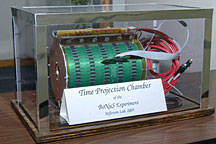- Number 361 |
- April 23, 2012
Snubbed protons tattle on neutron structure

The BoNuS experiment was carried
out in Jefferson Lab's Experimental
Hall B in the fall of 2005.
Protons and neutrons are the fraternal twins of the sub-atomic world and the building blocks of all atomic nuclei. While similar in many respects, it's their differences that give them their unique properties. Now, scientists conducting research at DOE's Jefferson Lab are exploiting these differences to gain deeper insight into these fundamental particles that build our visible universe.
Protons and neutrons are similar because they are made of the same building blocks, yet different because these building blocks come in different proportions. Both particles are built of three (valence) quarks, and both contain two of the six “flavors” of quarks discovered so far: up and down quarks. While the proton is made of two up quarks and one down quark, the neutron touts two down quarks and one up quark.
According to Wally Melnitchouk, a theorist in Jefferson Lab's Center for Theoretical and Computational Physics, by probing both the proton and the neutron, scientists can better learn how the different proportion of quarks yields different properties for these particles. Melnitchouk is a spokesperson for a collaboration of researchers who are conducting an experiment at Jefferson Lab to probe these particles.
"The proton is just one combination of ups and downs. So with the proton data alone, we cannot determine both up and down, we need the neutron," he says.
But probing the neutron is tough, even for Jefferson Lab's Continuous Electron Beam Accelerator Facility, which was built to probe the subatomic realm. CEBAF fires a beam of electrons into the nuclei of a target material. It can thump, transform or knock out particles that reside in the nucleus, so that scientists may study them.
However, there are no "free" neutrons to study. Once formed, a neutron that is not bound inside the nucleus of an atom will dissolve into simpler particles in minutes. "To study free neutrons, you'd have to replace your target every 10 minutes," Melnitchouk explains.
Sebastian Kuhn, also a spokesperson for the experiment, as well as chairman of the Jefferson Lab Users Group and a professor at Old Dominion University, says the experiment is, therefore, taking aim at the next-best thing: an isotope of hydrogen, called deuterium.
"What people are left with are nuclei that contain neutrons. And the simplest nucleus that we can possibly use is the deuteron; it's just one proton and one neutron. And that's what people have tried to study as an approximation to a free neutron. Subtract the proton and hope to get the free neutron," Kuhn explains. "What we set out to do with this experiment is to eliminate as much as possible any effects on the neutron, due to the fact that it's bound in a nucleus."
To minimize these effects, the scientists probed only those neutrons that were very loosely bound. Such neutrons had very little interaction with the proton in the nucleus immediately before or after the reaction. Knocking out the neutron disintegrates the nucleus, releasing the proton.
"There's a proton and a neutron: you hit the neutron, and the proton becomes a spectator, it just watches what happens to the neutron. So you look for that proton to come out," Kuhn says. "We only choose events where the proton was moving backwards relative to the electron beam, and at low momentum. Those are the two signatures we use to distinguish spectator protons from anything that was involved in the reaction: backward and slow."
The scientists developed a new piece of equipment, the Radial Time Projection Chamber, to capture and measure the slowly moving protons.
The experiment, dubbed BoNuS (for Barely Off-Shell Neutron Structure), was carried out in Jefferson Lab's Experimental Hall B in the fall of 2005. After careful and detailed analysis, the results were just published in the April 8 issue of the journal Physical Review Letters.
Among other results, they studied the likelihood that scattering electrons can alter the neutron to form so-called resonances.
"A resonance is an excited state, which basically means that the internal configuration of the quarks changes in a well-defined manner. For instance, one quark changes its spin, or two quarks start moving around each other, or some other changes of the internal motion occurs that lead to a new, more energetic state of the neutron," Kuhn says.
While some of the proton resonances are well-documented, there has been little exploration of the neutron resonances, since, until now, the neutron has been difficult to probe. This is the first experiment to reveal a sequence of neutron resonances. Encouragingly, the sequence appears to, in some ways, mirror the sequence of proton resonances.
"This will allow us to study the differences between the spectrum of resonance excitations of the neutron and the proton," Melnitchouk says. "We now have a way of directly studying the structure of the free neutron; this is just the first glimpse. But this experiment demonstrates that this method works and opens up a whole new range of experiments to study the structure of the neutron."
Beyond new information of resonances of the neutron, the BoNuS experiment also offers a direct view of the motion of the quarks inside the neutron.
The scientists say now that the experimental method has been confirmed, they plan to use it in future experiments with the energy-upgraded electron beam at Jefferson Lab to continue probing the neutron, in hopes of revealing more of its structure and of the behavior of the quarks inside.
"For the first time, we can directly compare the structure of the neutron to that of the proton, and we can then start explaining the differences in terms of fundamental properties of bound quark states," Kuhn says.Submitted by DOE’s Jefferson Lab
